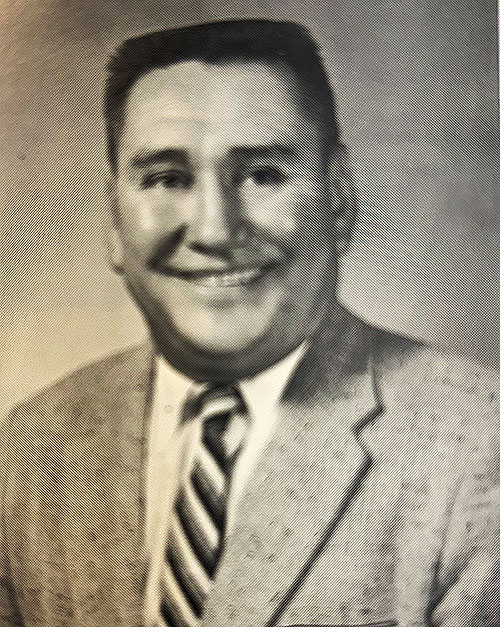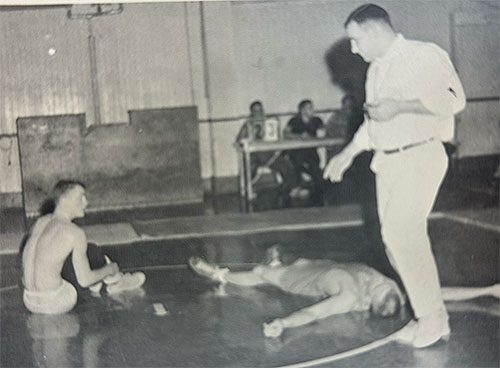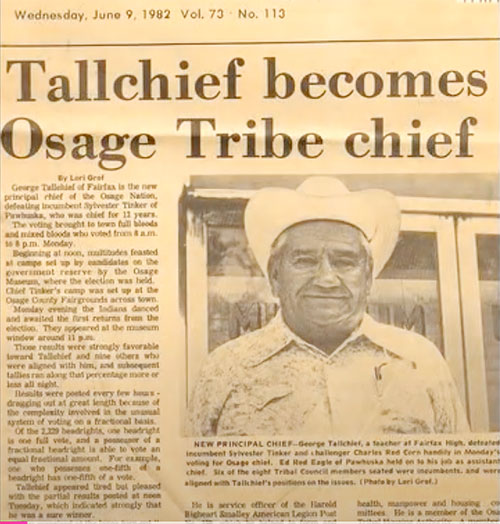Principal Chief: George Tall Chief's Osage Legacy
 Over his 96 years, George Tall Chief MAEd ’58 held many titles: Teacher, coach, principal, superintendent, husband, father.
Over his 96 years, George Tall Chief MAEd ’58 held many titles: Teacher, coach, principal, superintendent, husband, father.
But while it was part of his surname, there is one title that forever links him with his Native American heritage: Chief.
A member of the Osage Nation and one of the tribe’s most noteworthy families, much of Tall Chief’s life was spent coaching and teaching the youth of the West. His journey included seven years as a physical education instructor and coach at Pacific University, where he earned his master’s degree in 1958.
However, after returning to his native Oklahoma in the late 1970s, education and coaching gave way to tribal leadership. In 1982, Tall Chief was elected as chief of the Osage Nation, serving two terms from 1982 to 1990.
Tall Chief led the Osage Nation at a time when its people were grappling over revenues on oil drilled for on reservation lands and, specifically, which tribal members would receive “headrights” to benefit from those proceeds.
In an interview with the Osage News in 2009, Tall Chief, who died in 2013, was matter-of-fact in describing his role as chief. “The tribal council made the laws and I had to interpret them,” he said. “We primarily took care of the oil business.”
Throughout his life journey, whether teaching high school students, coaching young men on the gridiron and baseball fields, or leading the people of the Osage Nation, Tall Chief succeeded on leaving his mark not only at Pacific, but also on the larger world.
 EVERYONE LIKED HIM
EVERYONE LIKED HIM
Years before he became fully invested in tribal operations, Tall Chief was more interested in X’s and O’s and the evolving role of quarterback.
In 1956, Tall Chief arrived at Pacific University to pursue a master’s degree in education. A standout football player at Central State College in Edmond, Oklahoma (now the University of Central Oklahoma), Tall Chief quickly found himself as part of Paul Stagg’s coaching staff. By the end of the year, Tall Chief was appointed head coach of both the wrestling and baseball programs, positions he held throughout his Pacific career. After earning his master’s degree in 1958, Tall Chief also became a member of the physical education faculty.
Former athletes remember Tall Chief with great reverence. He was smart and had a great knowledge of sports, remembers Tim Schauermann ’66, a trustee emeritus who played American Legion baseball for Tall Chief in the early 1960s. More importantly, he remembers Tall Chief just being a nice guy.
“He just connected with people,” Schauermann said. “He was outgoing and connected with everybody. And he was friendly. Everyone liked him.”
“He was a good old soul,” said Marv Rueck ’61, who played both baseball and football for Tall Chief. “Back then he did it all. He was a wrestling coach, a line coach in football and he covered baseball.”
 Chuck Petersen ’60, who won an NCAA regional wrestling championship for Pacific in 1959, credits Tall Chief with keeping the Pacific wrestling program going after it nearly went defunct before his arrival. Success came even though Tall Chief had never been a wrestler.
Chuck Petersen ’60, who won an NCAA regional wrestling championship for Pacific in 1959, credits Tall Chief with keeping the Pacific wrestling program going after it nearly went defunct before his arrival. Success came even though Tall Chief had never been a wrestler.
“He was pretty strict (as a coach),” Petersen recalled. “But he took care of the program. No one else seemed to want it back then.”
Schauermann, Rueck and Petersen agreed that while Tall Chief was the head wrestling and baseball coach, his first love was football. For his master’s thesis, Tall Chief chronicled the evolution of the quarterback in the sport from 1880 to the present. When Stagg left Pacific in 1960, Tall Chief remained on the staff of his Stagg’s successor, Noah Allen, who himself was a Native American and member of the Creek Nation.
When the Dallas Cowboys used the Pacific campus for their first training camp in 1960, Tall Chief served as the official liaison between the university and the new NFL franchise.
Tall Chief departed Pacific in 1963 to become a teacher and head football coach at La Grande (Oregon) High School. He made teaching and coaching stops in Idaho, Colorado and Montana before eventually returning to Oklahoma in 1978.
A NOMADIC EXISTENCE
Traditionally, the Osage Nation was considered a semi-nomadic tribe with a lifestyle that combined village life with seasonal movements. Tall Chief followed a similar nomadic existence through the first five decades of his life.
Born in 1916 in Arkansas City, Kansas, just across the Oklahoma border from the Osage Reservation, George Tall Chief was the son of Eves Tall Chief, “a tall, striking full-blooded Osage” as George described him to the Osage News. “My dad was real tall, a rancher, an outstanding steer roper and he was a good dad.”
In 1925, Eves Tall Chief died under mysterious circumstances and is considered a victim of the Osage “Reign of Terror,” where many Osage people were murdered for access to their land and mineral rights. The period has since been explored in a 2017 book, Killers of the Flower Moon, which led to an award-winning 2023 movie of the same name.
At the time of his death, Eves was on his way to Oklahoma City from their hometown of Fairfax to testify against William King Hale, who was convicted in 1926 for the murder of another Osage landowner. While Hale was never officially connected to the death of Eves Tall Chief, he was suspected in having played a role in the deaths of at least 24 other tribe members.
Following Eves Tall Chief’s death, George, age 8, and his four younger brothers were sent to military boarding schools in Kansas and then Texas. George did not return to Fairfax until his sophomore year in high school.
Upon graduation from high school, Tall Chief won a football scholarship to Northeastern Oklahoma A&M University, where he also competed as a Golden Gloves boxer. He eventually transferred to the University of Central Oklahoma, where he graduated with a degree in education in 1945.
After starting his teaching career in Oklahoma, Tall Chief moved to Forest Grove. His seven years at Pacific proved to be the longest he spent in any one place before returning to his home state.
 FROM TEACHER TO CHIEF
FROM TEACHER TO CHIEF
After leaving La Grande, Tall Chief found himself increasingly hired for school administration roles. After teaching for a year on the Fort Belknap Reservation in northeastern Montana, Tall Chief helped the Assiniboine tribe secure $5.5 million to start Lodge Pole School, a charter school in Hayes, Montana. Tall Chief served as the school’s superintendent for six years.
In addition to teaching and coaching, published accounts have Tall Chief working in various other professions over the years, including as a professional rodeo clown and bull rider, an appaloosa horse breeder, and as having played a miner and Indian in the 1969 Clint Eastwood film Paint Your Wagon (though IMDB.com does not list him as a member of the cast).
In 1978, Tall Chief returned to Oklahoma, serving as principal at Crescent High School for two years before returning to his alma mater in Fairfax to teach and coach football and, after some convincing, run for chief.
“When I came back and the [tribal] elections were coming up and people were asking me to run, I said, ‘It’d be foolish for me to run for chief because no one knows me,’” Tall Chief told the Osage News. “They asked me three times before I decided to run.”
In 1982, Tall Chief was elected by the Osage people as its new principal chief, defeating incumbent Sylvester Tinker, who had held the position for 12 years.
“The phone rang, and I answered it and they said, ‘Hey, you’re the new chief,’” Tall Chief recalled in Ki-Hi-Ka Ste’: Life of Chief George Tall Chief, a documentary on his life produced by his granddaughter, Amy, in 2010. “I said, ‘Whoa. Wait a minute. I’ll be over soon because you might be telling me a lie.’ So I went over and, sure enough, I had won by a pretty good margin.”
After serving eight years as chief, Tall Chief continued to dedicate time to Osage Nation governance. He was president of the first Osage National Council, which developed a new form of government for the tribe that was eventually adopted in 2006, and remained active in tribal affairs well into his 90s.
While a full accounting of Tall Chief’s accomplishments as chief are not readily listed, it’s clear that his work on behalf of the Osage people brought further prestige to a name that was already linked with excellence among members of the tribe.
His niece, Maria Tall Chief, was considered America’s first major prima ballerina through the second half of the 20th Century, performing with the New York City Ballet and the Ballet Russe de Monte Carlo. Her likeness is on a U.S. quarter released in 2023 as part of the U.S. Mint’s American Women Quarters Program. Maria’s sister, Marjorie, also became an accomplished ballerina and was the first American to be named “premiére danseuse étoile” of the Paris Opera Ballet.
George Tall Chief was one of the first chiefs inducted into the Native American Hall of Fame and received the Peace Chief Award. But more than any award, he earned the respect and honor of his people, the ones he served.
“We are saddened by the passing of former principal chief George Tall Chief,” said John D. Red Eagle, then the principal chief of the Osage Nation, upon Tall Chief’s passing in the Pawhuska Journal-Capital. “We are grateful for his contributions to the Osage Tribe of Indians.”


